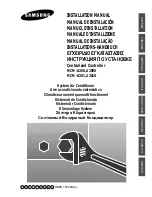
14
EN
• A place which provides enough space around the outdoor unit as shown in the diagram. (
)
see page 4.)
• A place which can bear the weight of the outdoor unit and does not allow an increase in noise level and vibration.
• A place where the operation noise and discharged air do not disturb neighbors.
• A place which is not exposed to a strong wind.
• A place free of combustible gases.
• A place which does not block a passageway.
• When the outdoor unit is to be installed in an elevated position, be sure to secure its feet.
• This air conditioner accepts a connection piping length from 2 m to 20 m.
• There is no need to add refrigerant as long as the length of the connection piping is 15 m or less.
• You will need to add 20 g of refrigerant per meter of added connection piping for installations requiring connection piping to be
between 15 m to 20 m.
• An allowable height level is up to 10 m.
• A place where the drain water does not cause any problems.
Precautions for Adding Refrigerant
• Use a scale having at least 10 g per index line presision when adding the refrigerant. Do not use a bathroom scale or similar
instrument.
• Use liquid refrigerant when refilling the refrigerant. Since the refrigerant is in liquid form, it can fill quickly. Therefore, perform the
filling operation carefully and insert the refrigerant gradually.
• Do not use the supplied drain nipple for draining water. Drain the water from all
the drain holes directly.
• To protect the outdoor unit from snow accumulation, install a holding frame, and
attach a snow protection hood and plate.
* Do not use a double-stacked design.
• Holes are provided on the base plate of the outdoor unit to ensure that the
defrost water produced during heating operations is drained off efficiently. If a
centralized drain is required when installing the unit on a balcony or wall, follow
the steps below to drain off the water.
1.
Proceed with water-proofing by installing the water-proof rubber caps
h
in the
2 elongated holes on the base plate of the outdoor unit.
[How to install the water-proof rubber caps]
1) Place four fingers into each cap, and insert the caps into the water drain
holes by pushing them into place from the underside of the base plate.
2) Press down on the outer circumferences of the caps to ensure that they
have been inserted tightly.
(Water leaks may result if the caps have not been inserted properly, if their
outer circumferences lift up or the caps catch on or wedge against
something.)
* When water still leaks even after performing steps 1) and 2), add caulking
material, putty or other sealants.
5 INSTALLATION OF OUTDOOR UNIT
Installation Location
Precautions about Installation in Regions with Snowfall and Cold Temperatures
CAUTION
1.
Install the outdoor unit in a location where there are no obstructions near its air intake or air outlet.
2.
When the outdoor unit is installed in a place that is always exposed to strong winds like on the coast or on a high story of a
building, secure the normal fan operation using a duct or a wind shield.
3.
Especially in windy areas, install the unit to prevent the admission of
wind.
4.
Installation in the following places may result in trouble. Do not install
the unit in such places.
• A place full of machine oil.
• A saline-place such as the coast.
• A place full of sulfide gas.
• A place where high-frequency waves are likely to be generated, such
as from audio equipment, welders, and medical equipment.
Draining the water
Snow protection plate
Snow protection hood
At least
50 cm
Snow accumulation line
Holding frame
Anchor
bolts
Front
Install at least 50 cm
above the snow
accumulation line.
Strong
wind
h
Water-proof rubber
caps (supplied with the
outdoor unit)
g
Drain nipple
Base plate
Содержание RAS-18PAVP-E
Страница 25: ......
Страница 26: ...EG44550301 ...











































